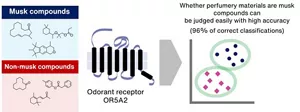Research on Odorant Receptors
Control of Fragrance and Unpleasant Odors
There are approx. 400 kinds of odorant receptors in the human nose. When these receptors recognize certain volatile substances and the information is transmitted to the brain, we can recognize odors (video).
Odorant receptors are difficult to analyze and we have little knowledge about what odor molecules they recognize. Many of the odorant receptors are unstable on cultured cells, which has previously made it difficult to examine the reactions of receptors to perfumery materials by giving them to cultured cells from outside in experiments.
To solve this challenge, Kao introduced a protein engineering approach and succeeded in forming odorant receptors as stable membrane proteins on the surface of cultured cells. For example, we identified OR5A2, a receptor that recognizes perfumery materials with a musky odor. We then built a machine-learning model based on information on the chemical structures of odor molecules the OR5A2 recognizes and does not recognize. We can now use this model to predict with high accuracy whether a certain substance smells musky*1 (Figure 1).

Figure 1 Discovery of an odorant receptor that comprehensively recognizes musk compounds and building of a musk compound prediction model
We believe that the method established in this research will deepen our understanding of the nature of the sense of smell and how the sense of smell is generated via odorant receptors.
Process from Sensing of Volatile Substances in Olfactory Receptors to Recognition of an Odor by the Brain
The following video does not include audio, and a text transcription of its visual content is available.
A transcript is available here.
This video illustrates what is happening in the nose and the brain when we sense an odor.
0:00 A woman is entering a bakery and sensing the smell of bread.
0:06 An image of the inside of the woman’s nose appears on the screen. Odorous substances from the bread are recognized by the olfactory nerve behind the nose.
0:18 The olfactory nerve expands. It then uses odorant receptors as sensors to detect the odorous substances and gets excited.
0:27 The excitation in the olfactory nerve behind the nose is transmitted to the brain.
0:33 The response pattern of approx. 400 odorant receptors to the odorous substances in the bread is translated into a neural activity pattern in the brain, which makes the woman sense it as the smell of the bread.
- Home
- Innovation
- Research & Development
- Fundamental Research
- Sensory Science
- Research on Odorant Receptors
- Home
- Innovation
- Research & Development
- Fundamental Research
- Sensory Science
- Research on Odorant Receptors
